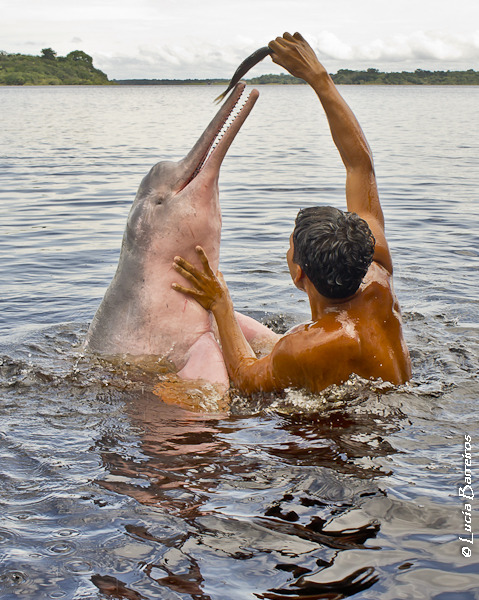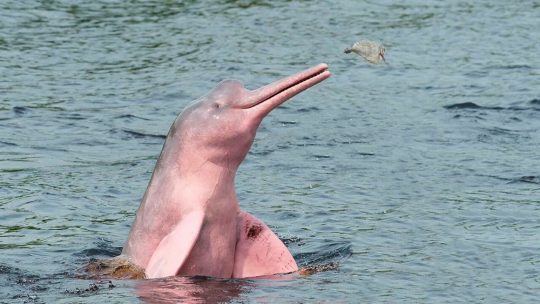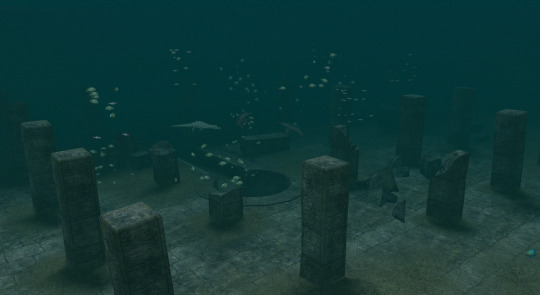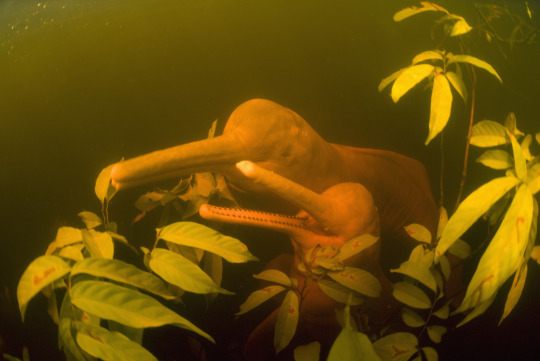#pink amazon river dolphin
Explore tagged Tumblr posts
Text


They’re dating
#i’m right and i should say it#amazon river dolphin#shark#bisexual#bi#bi pride#bisexual pride#bisexuality#bisexualism#sharks#amazon river dolphins#pink amazon river dolphin#bi positivity#bisexual positivity#bi post#bisexual posting
30 notes
·
View notes
Text

Pink
#amazon river dolphin#well known for being pink#and aggressive predators#she’ll be fine#swordtember 2024#rbswordtember#swordtember#rider art
26 notes
·
View notes
Text
Wet Beast Wednesday: Amazonian river dolphin
It's the last Wet Beast Wednesday of the year. I started doing this little project to help myself get used to Tumblr and encourage myself to use it more often. That absolutely worked and I'm going to keep going. For my first ever WBW post, I discussed an adorable cetacean, so I'm going to call back to that by discussing a less adorable cetacean. Meet the Amazonian river dolphin, also known as the boto, bufeo, and pink dolphin because, well look at it.

(image id: an Amazonian river dolphin peeking out of the water. It is a large dolphin with a long, thin snout, bulbous head, and small dorsal fin. Its entire body is bright pink. end id)
River dolphins are dolphins the exclusively inhabit freshwater. There are several species (from four to six depending on your source) that are not all closely related. Probably the most famous of these is the Amazonian river dolphin Inia geoffrensis. They live in the Amazon, Orinoco, and upper Maderia rivers of South America. There are three subspecies: I. g. geoffrensis (the Amazon river dolphin), I. g. humboldtiana (the Orinoco river dolphin), and I. g. boliviensis (the Bolivian river dolphin, previously considered a separate species). There is also debate on whether the Araguaian river dolphin should be considered a subspecies of Amazonian river dolphin or a separate species. A common name for the dolphins found throughout Brazil is boto, though this is also used to refer to another river dolphin species, the tucuxi, as well as marine dolphins that occasionally enter fresh or brackish water. The amazonian river dolphins is the largest river dolphin, with males reaching 2.5 meters (8.2 ft) and 185 kg (408 lbs). Males are larger than females, averaging 16% longer and 55% heavier. The most famous feature of these dolphins are their color. while they are born grey, they lighten up as they age, eventually becoming pink. The amount of pink varies between individuals, with some being grey with pick spots and others going full Barbie mode. It's not clear why they turn pink and why some are pinker than others. Possible explanations include the distribution of capillaries under the skin, consuming large amounts of pink pigment through their diet (the same thing that happens with flamingos), and exposure to sunlight. Males are generally pinker than females, which may be due to them accumulating larger amounts of pink scar tissue while fighting over females. The dolphins get noticeably pinker when they are excited, which may be similar to a human blushing.

(Image id: a dolphin holding its head out of the water, seen from the front. Its mouth is partly open, showing a single row of teeth within. It is pink. end id)
Amazonian river dolphins are not known for being the prettiest cetaceans. With long, skinny shouts, lumpy bodies, non-distinct dorsal fins, and scarred, rough skin, they won' be winning many beauty contests. Maybe its for the best that they don't have very good eyesight. When living in a place as murky as a major river, eyes often aren't that useful. They instead navigate almost exclusively through echolocation. While not as powerful as they eyes of oceanic dolphins, river dolphin eyes are adapted to take in any available light, letting them see better in low-light environments such as a murky river under a canopy of leaves. The bulbous head contains the melon, an organ found in cetaceans used for echolocation. The melon can change shape, which may help focus the echolocation for different purposes. Part of the lumpy profile of the boto likely comes from their lack of blubber. Living in a tropical river means that river dolphins don't lose nearly as much body heat and therefore don't need the thick layer of blubber that helps streamline oceanic dolphins. They also don't need to be as hydrodynamic as they are a lot slower than oceanic dolphins. While slow, river dolphins are maneuverable and can rotate their flippers to turn themselves around without having to swim in a circle. In addition, unlike oceanic dolphins, the boto's neck vertebrate are unfused, allowing them to turn their head side to side. All of this helps the dolphins navigate and search for food in crowded rivers and flooded sections of forest. Another unique feature is the presence of whiskers on their snouts and cheeks, which are believed to help find food when poking around in the mud and aquatic plants. Yet another unique feature is the fact that they are heterodonts. This means they have different types of teeth. In the front of the snouts are the sharp, conical teeth found in other dolphins, but the uniquely have molar-like teeth in the back. These are used to crush hard prey, such as shellfish and turtles.

(image: a dolphin partially breaching out of the water while upside-down. Its large fins are in the air and its head is turned soits chin is facing the camera. end id)
The diet of the Amazonian river dolphin is the most varied of any toothed cetacean. At least 53 species of fish are part of its diet, though it prefers croakers, chiclids, tetras, and piranhas. As mentioned above, its molar-like teeth also allow it to crush through hard-shelled animals including bivalves, crabs, and turtles. They have been known to cooperate with tucuxi dolphins and otters to hunt, with the different animal working together to drive fish out of hiding places. The dolphins practice seasonal migration to follow their prey. During the wet season, they travel into floodplains, lakes, flooded parts of forests, swamps, and other places that are inaccessible during the dry season. During the dry season, they travel back into the main river. Males return to the river sooner that females and calves. The dolphins are less social than other dolphins, usually traveling alone or in groups of 2-4 members, though larger groups do happen. They do communicate with each other using whistles. During mating season, which usually happens in late June or August, they will congregate in large numbers. Males attempt to court females by carrying objects in their mouths such as branches and leaves and by nipping at the female's fins. Males also become aggressive and will fight with other females and with females that refuse their advances. These fight often leave the males covered in scars and nicks that can be used by scientists to identify them. Males will attempt to mate with as many females as possible. Gestation takes just under a year and calves are born in May and June as the wet season is beginning. The calves will nurse for a year and stay with their mother for two to three years. Females will not mate until their current calf has left, giving a mating frequency for females of between 2 and 3 years. Males may attack calves to force the mother to mate again. The life expectancy of wild dolphins is unknown.

(image id: a dolphin holding a leaf in its mouth. This may be part of a courtship display or play behavior. end id)
Amazonian river dolphins are known to be curious, playful, and not fearful of unfamiliar objects. This may because adults have almost no natural predators. Jaguars, caimans, and anacondas will attack them, but prefer targeting calves over adults. They are known to play with sticks, plants, small animals, and other submerged objects. They are also reported to follow boats and rub up against them and grab oars with their mouths. This may be a combination of play behavior and following boats to catch fish they scare. River dolphins have also been reported to approach humans, usually children, and examine or play with them. Botos feature quite a bit in the mythology and folklore of the peoples of South America. A common myth states that the boto can come on shore at night and take the form of a human, a boto encatado. While appearing as beautiful people, they need to wear hats as their blowholes stay on their heads. Male encantados come to shore to party and seduce women, but must return to the river before the transformation wears off. Many illegitimate children are fathered when an encantado comes to town. Female encantados seduce and bewitch married men. She will visit him on the anniversary of their meeting for seven years. On the seventh year, she turns him into a baby and places him in his wife's womb. Some stories say that they come from an underwater paradise called Encante and visit humans to experience hardships and parties. It is said that people who travel the river at night, especially women and children, may be kidnapped by the dolphins and taken to Encante, from which they will never return. Other stories say that the dolphins can make beautiful music and control storms. Killing one brings bad luck, and eating one brings worse luck, while making eye contact curses you with nightmares. Their body parts had magic powers and were sometimes used as fetishes (not that kind) by shamans.

(image: a man with back to the camera hand-feeding a fish to a dolphin. end id)
Amazonian river dolphins are classified as endangered by the IUCN. Their largest threats come from humans. Overfishing leads to food loss and can lead to the dolphins becoming entangled in nets and drowning. Damming reduced their habitat and excess gold mining releases poisonous mercury into the water. Some are also killed to be used as bait. Fishermen have been known to kill dolphins who damage their equipment. Deforestation is also decreasing usable habitat. Amazonian river dolphins fare poorly in captivity and captive breeding is not considered a viable conservation method.

(image id: a dolphin calf being rescued by a conservationist. the person is holding it out of the water. The dolphin has the same body shape as an adult, but is grey instead of pink).
#wet beast wednesday#amazonian river dolphin#amazon river dolphin#river dolphin#pink dolphin#boto#dolphin#cetacean#freshwater biology#freshwater ecology#amazon river#biology#zoology#ecology#animal facts#cetaceans#boto encantado#encantado#image described#long post
90 notes
·
View notes
Text
🐬 Daily Cetacean Fact: 🐬
Amazon River Dolphin: also known as the boto or pink river dolphin, it is a species that is endemic to South America. The Amazon river dolphin is the largest species of river dolphin, with adult males reaching 408lbs in weight, and 8.2ft in length. Adults acquire a pink color, more prominent in males. They have one of the widest ranging diets, feeding on up to 53 different species of fish, such as croakers, catfish, tetras and piranhas. They also consume other animals such as river turtles, aquatic frogs, and freshwater crabs.


#amazon river dolphin#river dolphin#pink river dolphin#pink dolphin#amazon river#cetacean#river cetacean#respect the locals#marine animals#marine biology#marine life#marine#marine mammal#dolphin#dolphin post#cetacean post#daily cetacean#daily cetacean fact#cetacean fact#facts about cetaceans
43 notes
·
View notes
Text

Twilight Temple - Cortica River Upstream
Endless Ocean: Blue World, Nintendo Wii
this place is really lovely looking, but swimming out and looking at the whole thing like this kinda makes the creature placements look goofy to me...
#endless ocean#endlessocean#endless ocean 2#endless ocean blue world#endlessoceanphotos#wii#nintendo wii#green terror#blue discus#pink tailed chalceus#king gigide#amazon river dolphin#cortica river upstream
10 notes
·
View notes
Text
Brazilian folklore pt.4 🇧🇷
“ 𝐵𝑜𝑡𝑜 “
#brazilianfolklore #boto #pinkdolphin #seductor #merfolk #amazonriverdolphin #legend #art #artist #digitalart #digitalartist #digitalartwork #artoftheday #artofinstagram #instart #instartist #digitalillustration #digitaldrawing #illustration #kaleisillustrations #ibispaintx #procreate #ipadpro


#art#artwork#digital aritst#digital art#artists on tumblr#tumblart#ipaddrawing#ibispaintx#procreate#brazil#amazon river dolphin#pink dolphin
2 notes
·
View notes
Text
Brazilian folklore: this is how X came to exist. This is why X phenomena happens :). Snakes. This is why people disappear in the forest. More snakes. This is another reason why people disappear in the forest. YOLO SACI PERERE. Here is another reason why people disappear in the forest. MORE SNAKES
I love folklore so much because depending on the location and era it comes from it's either the most terrifying concept or the dumbest thing you've ever heard
#folklore#listen#I love brazilian folklore there's so many fun things like saci perere aka local trouble maker#like anything bad that happens you can blame on him#it's him pulling pranks on us#then there's also like werewolves#and the headless mule with fire coming out of the head stump#who's either a woman who got cheated on or did the cheating herself#and her punishment is to roam brazil to murder anyone who did the same crimes#I know of at least like 3 different virgin births stories which is kinda wild when you think about it#there's the pink river dolphin that rapes girls#there's the amazon mermaid who wants to kidnap men to make her husbands/slaves#there's the protector of the forest who hunts humans looks human but has fire for hair and his feet are backwards to confuse trackers#idk I love it#really wild stuff and I love it so much#but yeah a lot of it is#SNAKES#and#HERES ANOTHER REASON WHY YOU DISAPPEAR IN THE FOREST#(that mermaid one being one of them)
86K notes
·
View notes
Text
Every time I learn that a pink animal exists somewhere out there, the little girl in my heart does a cartwheel.
0 notes
Text

Amazon River Dolphins. Based on an image that I found in Google (photographer unknown)
Marker in sketchbook
2023
#traditional art#sketchbook#spooky#horror#weird#ink#dolphin#amazon river dolphin#pink river dolphins
1 note
·
View note
Text

#inia geoffrensis#inia#dolphin#river dolphin#amazon river dolphin#bufeo#boto#pink river dolphin#iniidae#cetacea#october#mspaint
1 note
·
View note
Text
Turns into a dude or lady who gets people pregnant and goes back into the river. (Encantado guards manatees, and gives people nightmares.

7K notes
·
View notes
Text
Free Kindle Version of "A Dolphin's Tale" Available Saturday April 22 through Wed. April 26th
Kindle book giveaway for "A Dolphin's Tale" Saturday April 22 through April 26
There have been recent sightings of Pink Dolphis (once thought extinct) in the Mississippi and there have been pink dolphins in the Amazon for eons.�� Native Amazonians believe the pink dolphins (locally called Botos) are so very fond of humans that they can appear to be beautiful humans at night. The pink Boto's brain is 20% larger than a human brain.
Disney studios considered making this story an animation but finally declined giving their reason as competing with "The Little Mermaid."
#pink dolphin#dolphin#amazon river#amazon river dolphin#amazon river natives (riberenos)#legends of the amazon#shape-shifting#Boto
0 notes
Note
(sorry this is from a week ago but) Wait, what's going on right now that's complicated with Amazonian farmers' land rights?
Not farmers, indigenous people
See, recently they put a new law through congress that severely reduces indigenous land to the borders established during the late dictatorship, or immediately post-dictatorship, in 1988. An absolute joke of a border that was dreamed up by some military assholes. People in america may recognize this type of society from the times of westward expansion and think this is a thing of the past because for you guys it is. But here it is a reality. Murder is rampant. The reach of the law is incredibly limited. Government is just too weak and landowners basically run things. THAT'S WHY it's so important to donate directly to the native peoples instead of random NGOs because native people are fucking there and the more power they hold in the land the safer the land will be from agroindustrial expansion.
Well the law was vetoed by the the president and the Supremo Tribunal Federal, aka supreme federal court, labeled it as unconstitutional. Which it is, because our 1988 constitution describes native american land rights in some of its first articles. We thought this would be it for the law
But then the senate (that already overrepresents landowners in rural states) just went along and approved it anyway. I had no idea they could approve something unconstitutional. The progressives and particularly the socialists are fighting this in court. But it happens that for now the legal border is the severely reduced version.
Doesn't mean they'll just give up, because as it happens we don't have any stand your ground laws so even if you own a piece of land, you cannot legally speaking just shoot everyone there. Or attack or threaten them in any way. They'll just have long legal battles individually for the rights to occupy land based on use. Also the Xingu national park, the largest preserved land of the Amazon described as 'larger than Belgium', is being encroached by huge farms that are poisoning their water supply. The border is Visible. I'll try to find video of it but essentially you have a forest and a desert separated by a strict line.
Just last week in the south of Bahia (not the Amazon, let me explain more about the Amazon situation in a bit) Hãhãhãe leadership Nega Muniz Pataxó was shot and killed by an armed militia group that invaded and occupied the Caramuru territory.
instagram
The situation in the Amazon, specifically the yanomami territory in Roraima our northernmost state, aka deep forest, is more dire than average given difficulty of access, sheer size, and government abandonment. It's a place that depends on government aid for medicine. It's land that is being systematically invaded by gold miners, pandemic, toxins from nearby farmlands, wood extraction etc. (wood extration is rampant everywhere tho). Early 2023 saw a massive federal government operation by now president Lula to empty the mines and try to look for where funding comes from. Yanomami land is still being invaded to this day, the struggle is ongoing.
The yanomamis need support right now more than any other. Last year saw a massive heat wave that (well, one, caused a girl named Ana Clara Machado to die during the Taylor Swift concert. This is unrelated but I feel like not enough foreign media covered this, Taylor even lied about it as well.) dried up a lot of rivers, killed a LOT of fresh water animals including an unprecedented amount of pink dolphins. Access that was already hard became damn near impossible without boats. I cannot overstate how many pink dolphins were found dead.
Another technique that landowners use to clear space for farms is to just set things on fire and then occupy the empty land, which they legally can do to land that was naturally burned in a forest fire. It happened that Pantanal, another national park of swampland, was massively devastated by fires last year too
this article is from 2020, the year that the worst fire happened, but in 2023 there was another one. It's been happening yearly now due to a) deliberate action and b) climate change aggravation.
And this is not nearly all. Just off the top of my head. If you speak portuguese I recommend following the APIB or the COIAB on instagram to keep up with the news. The FUNAI is the government branch of indigenous organization, but it's not generally that well liked. Still.
807 notes
·
View notes
Text
Pink Dolphins
I've read two posts with absolutely atrocious information about pink dolphins and rather than succumbing to the evil urge to correct people who are WRONG ON THE INTERNET (woe) I'm going to make my own post.
first of all "that's a bottlenose dolphin that's been photoshopped pink/generated by an art bot" yes that's pretty likely but ALSO, real albino dolphins can be VERY PINK INDEED, more than you'd ever think! but only some of the time... when an albino dolphin is exerted or excited their pale skin flushes with blood, making them look very pink (please look up dolphin skin biology sometime I won't get into it here but it's all kinds of wonderfully fucked up)
As an example, this is Supika (スピカ), an albino common bottlenose housed at the Taiji Whale Museum in Japan. As you can see she's nearly white when calm, but a shining rosy pink when excited and swimming about (source)

There are also dolphin species that are naturally pink! The one everyone always hastens to mention is the classic "pink dolphin": the amazon river dolphin (Inia geoffrensis) of Boto myth:

These guys start grey and get more pink as the grey scuffs off, with the adult males generally ending up pinker due to being larger and rowdier. Amazon river dolphins have a keel along their back, large flappy pectoral fins, dark teeth, and a very unique beak and general bone structure: Their neck vertebrae allow their heads to turn much more than other dolphins, which gives them big creases on either side of their necks, almost looking like gills. there's maybe several subspecies or even distinct species and they all look very slightly different, but those are the important traits they have in common.
These traits set them apart from the Indo-Pacific humpback dolphins (Sousa chinensis), which are another commonly grey-to-pink dolphin that are VERY OFTEN mislabeled as amazon river dolphins. imo it's pretty easy to tell the difference because 1.) their photos are taken in wave-chopped open ocean waters not brown/green amazon waters, and 2.) they look so much more... dolphin-like (apologies to the boto) (source)

Most "pink dolphin" photos you see online are either of these guys or of "Pinky", an albino bottlenose living in a brackish lake system in Louisiana in the USA (and her calf), but there's one more I know of that can be slightly pink:
The tucuxi (Sotalia fluviatilis) looks like a smaller cuter bottlenose and also inhabits the amazon. The closely related costero or guiana dolphin (S. guianensis) is its estuary/coastal cousin, and both of them can not only flush strongly pink but also a lovely soft purple! (the costero was also the first type of dolphin confirmed to have electrosense, but we won't get into that here) (source)

And finally, another thing that is important to note is that some oceanic dolphins with pale markings or patches, especially on their bellies, can flush pink, for pretty much all the same reasons this might happen to a pale-skinned human!
(Tursiops sp.) (source)

(Steno bredanensis) (source)

194 notes
·
View notes
Text

Amazon river dolphin! The pink one!
[ID: a digital illustration of a pink and grey dappled dolphin leaping, facing to the right on a dark teal background. It is smiling and is surrounded by decorative, stylized waves and splashes. End.]
223 notes
·
View notes
Text

Did you know there are pink dolphins? Meet the Amazon river dolphin (Inia geoffrensis). Found in the Amazon and Orinoco rivers, this species is known for its rosy complexion. How pink it is depends on the water it lives in: the Sun can have a fading effect on its signature color, so living in murkier water can help it retain its pink hue. To track down prey, including piranhas and cichlids, it uses echolocation and the hairs on its snout.
Photo: Ana Claudia Jatahy - MTUR, Public Domain, Wikimedia Commons
577 notes
·
View notes